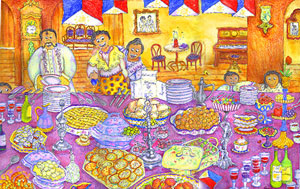

|
What's the best thing that comes after mass and the opening of gifts on Christmas Eve? That's right! The foooood! Many Filipinos call this holiday feast "Noche Buena;" others, "Media Noche." Literally, Noche Buena means "good night" and Media Noche, "midnight" in Spanish. Beyond that, most of those I talked to don't really know the difference, or much less insist that what they call the feast is right. Except my Lola Tesay. She says "Media Noche" can stand for any midnight snack or meal, even in wakes. She says that for Christmas Eve, it's "Noche Buena" because it's welcoming Mama Mary and Baby Jesus into the home. That's a good idea. But anyway, everybody agrees that the food is really very special -- so special that some, if not all of it, is served ONLY at Christmas. Like what? Ah, that depends on the family. We're most familiar with puto bumbong and bibingka that we get from vendors around the church. Steaming hot with grated coconut, the butter melting on top of them, mixing with sprinkled sugar - mmmm! Cebuanos and other Visayans have puto-maya enjoyed with cups of either tsokolate espeso (rich, thick, hot chocolate drink) or tsokolate aguado (not so rich with more water). Puto-maya is actually more like suman than the puto we know. It's malagkit na bigas cooked by steaming and flavored with a little ginger, coconut milk, and some sugar. We scoop it onto our plates because it's not wrapped in banana leaves. And it's perfect too with scoops of sweet, ripe mangoes - if you can get some at Christmas. In Laoag, people cook tupig, another type of suman that's so yummy, you'll eat so many. It's made of powdered malagkit so it's a little smooth, flavored with molasses and coconut. To cook it, they bury it under a burning mound of rice chaff, so you also get that special smoked flavor. Aaahh! Then south of Ilocos, in Vigan, they cook tinubong in a very unique manner. They pour some half-cooked puto batter into long bamboo tubes. They put these tubes over burning coals. By the time the coals die down, the bamboo is charred and ready to cut. Each family member gets a cut of the bamboo filled with hot, cooked tinubong. Those are just some of our native delicacies that come out only during Christmas. But times change, of course. Now there are people selling them all throughout the year. For older people, eating Christmas food outside the holiday season brings back memories. For youngsters like you, however, you might just grow up thinking that they're not exactly Christmas-only food. Actually, the changes are not just with the native delicacies - and whether they're on the Christmas table or not. For example, I remember what my parents told me. They said that when they were young, their Noche Buena would always be queso de bola and Chinese ham cooked in sweet, fruity syrup. They also had castanas, like in the song "Chestnuts roasting on an open fire…" We also had those when we were younger, when our doctor uncle was given lots of those by his patients. Then when times got harder and our uncle had passed away, we looked past expensive ham and smelly queso de bola and bland chestnuts. We saved our money to buy different chocolates. We learned to mix different kinds of salads, experimenting with new ingredients every season. Mama cooked chicken hamonada and baked special kinds of bread. We made cookies, different kinds of polvoron, caramel popcorn. I know one family who cooked Japanese food one Christmas; another baked their own pizza and pasta. The idea is (and it always has been) preparing food that's really great-tasting that you probably can't find anywhere else. Or at least each member of the family tries to make something that he or she is good at. After plenty of Christmases, when you get as old as I am, you'll discover something else about Noche Buena. I saw it just now, and I can tell you while you're still young: There are some other things that make the food - and the feast - really special: that we prepared it together as a family and that we were going to enjoy it together. That it comes only once a year, when we brothers and sisters were at home and on a holiday break makes it doubly special. Which is probably the point of Noche Buena. Tradition or no tradition, it doesn't matter what you eat but who you share it with - on that particular Christmas Eve. |
